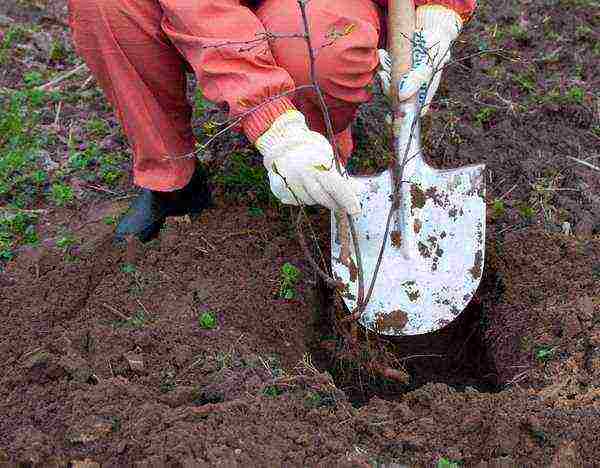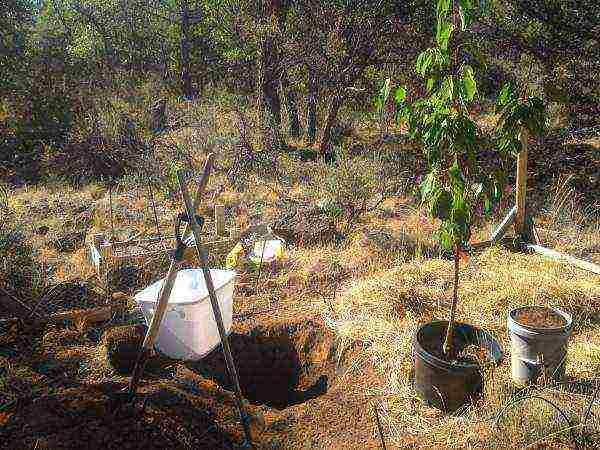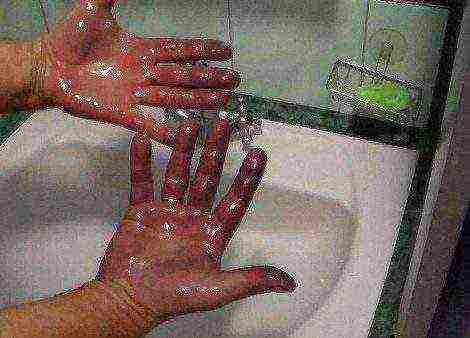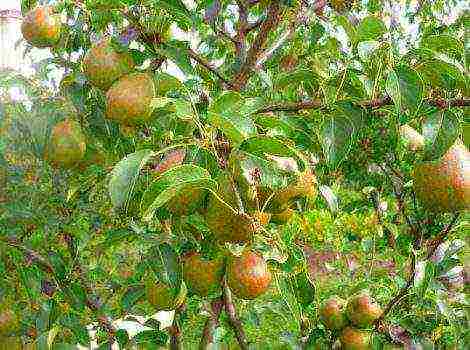Content
How to plant cherries in the fall
Planting cherries, like any other fruit tree, has its own characteristics.
It can be held both in spring and autumn.therefore every gardener should be aware of the differences between these types of work.
When to plant cherries - in spring or autumn?
For garden plots located in the south of Russia or in the Central region, the most preferable would be the autumn planting.
These terms are due to the fact that during this period, the trees are in a dormant stage, and all their forces will be directed to rooting in a new place, and not to flowering and foliage formation.
If the purchased seedling was not transplanted into open ground until the end of October, then for the winter period it is buried in the ground and planted in the spring.
Spring planting is optimal for Siberia and other regions with a harsh and cold climate, usually this procedure is carried out from the end of April to the beginning of May.
Why it is advised to plant in the fall: benefits
In the autumn period many seedling sellers offer discounts on their products. In addition, for those who have not yet decided on the choice of the variety, in the fall you can see the expected result and taste the fruits of various varieties.
As known, heavy rainfall in autumn, therefore, the gardener gets rid of the need to constantly water the planted tree and monitor the level of soil moisture.
Saplings planted in autumn will have time to grow young roots during the winter... Because of this, they will begin to grow much faster than trees planted in spring.

In the southern regions autumn planting has many more advantages than spring planting... Because the risk of a sudden onset of heat is eliminated.
Young trees may not be prepared for the winter cold. Therefore, they can die due to too low temperatures, gusty winds or snowfalls.
It often happens that the tree survives after the winter season, but broken off or frozen branches appear. Also, a danger can be posed by rodents that gnaw the bark of a tree trunk.
Simple rules for proper cultivation
In northern regions, it is not recommended to use autumn planting.because it is more likely that young trees will not be able to survive the harsh winter climate and will simply die.
When purchasing several seedlings at once, they are tied together. When digging them into the ground, you need to make sure that the top is directed to the south side.
With the onset of cold weather, the tree must be protected from their negative influence. The branches are covered with earth and snow, they will be reliable protection against freezing. Also, to avoid sunburn, cherries are covered with plywood.
How to plant a tree
In order for the sweet cherry to develop well after the autumn planting and give a rich harvest, all preparation rules must be followed, both the soil and the seedling itself.
Preparation of seedlings
Sweet cherry differs from other fruit crops in that if you grow a seedling from a seed, it will not inherit the characteristics of the parent tree.The quality and quantity of the crop will be either more or less.
Therefore, to obtain the desired result it is recommended to buy an already grown seedling in a garden nursery... In order for the purchase to be successful, you need to pay attention to the following indicators:
- On the trunk of the tree, the trunk of the scion should be clearly visible. It is these seedlings that will have all the characteristics of the acquired variety.
- When choosing a seedling, you need to pay attention to the presence of a main guide, if it is absent, then the tree will branch strongly and grow poorly, and there will also be a risk of breaking the crown into several parts after abundant fruiting. If the conductor is broken, then in the future it may have competitors, such rivalry will adversely affect the state of the cherries.
- The roots of the seedling must be well developed and at least 15 centimeters long. You also need to pay attention to the condition of the root system, the absence of mechanical damage and excessive dryness indicates the quality of the seedling, and the proper care for it. The place of the cut should be colored in a light, creamy shade.
- Best of all, trees at the age of 1-2 years take root in a new place.

Seedling roots with an open root system, during transportation, it is wrapped in a wet cloth, and then in an oilcloth.
Before planting, the roots of the seedling are inspected again and eliminate all emerging shortcomings:
- all soaked ends are cut off;
- you also need to remove all those roots that do not fit in the dug hole. Roots that are too long can freeze during the winter;
- before planting, the root system is placed in water for 2 hours so that it is moistened; in the presence of dry roots, this procedure is increased to 10 hours.
If foliage is present on the purchased seedling, it must be removed immediately.so that it does not dehydrate him.
Site selection and preparation
A place for planting and growing a seedling choose based on the following preferences for cherries:
- Cherry grows best in loam or sandy loam soils, because they can provide good water and air permeability. Also, fertilizers applied to such land will go to the root system much faster and ensure its growth.
- The optimal level of groundwater occurrence is 1.5 meters, if it rises higher, that is, there is a risk of moisture stagnation and subsequently rotting of the root system. But this problem can be solved by digging a drainage ditch in which all excess moisture will collect.
- Cherry also loves sunny and lighted areas, it is best to plant it on the south or southwest side of the garden.

2-3 weeks before preparing the planting pit you need to carefully dig up the entire area on which you plan to plant cherries and apply the following fertilizers for digging:
- 10 kilograms of manure or compost is applied per square meter;
- 180 grams of superphosphate will be consumed on the same area;
- 100 grams of potash fertilizers;
- acidic soils must first be limed with lime or dolomite flour. For sandy loam soil, 400-500 grams of the composition are used per square meter, and for loamy ones, 600-700 grams.
If the site has a sandy type of soil, then a few years before planting cherries, it is mixed with clay, and vice versa. At the same time, throughout the entire time before planting, the land must be thoroughly fertilized in order to make it more fertile.
2-3 weeks before planting cherries, dig a planting hole, the depth of which will be equal to 60-80 centimeters, and the width can range from 60 to 100 centimeters.
When digging a hole, you need to separate two layers of soil: fertile (upper) folded to one side, and infertile to the other.
After the pit is ready, a stake is driven into its bottom, which will serve as a support for the future tree. The topsoil is then mixed with the following fertilizers:
- 2-3 buckets of humus or non-sour peat;
- 200 grams of superphosphate;
- 60 grams of sulfuric potassium;
- 500 grams of ash.
Then the resulting mixture is poured into the bottom of the pit in the form of a mound and carefully tamped, then sprinkled with infertile soil.
When preparing the pit, nitrogen fertilizers must not be applied.because they can damage the root system of the seedling.
Landing in open ground
Experienced gardeners recommend when planting cherries adhere to the following technology:
- The seedling is placed in a hole so that the root collar is 3-5 centimeters above ground level and tied to a support stake.
- The root system must be carefully straightened and spread over the surface of the mound.
- Then the tree is sprinkled with the lower layer of soil, gradually shaking it, thereby filling the voids between the roots.
- After the seedling is half buried, 1 bucket of water is poured into the hole, then the process is continued.
- At the next stage, a hole is dug around the trunk with a depth of 5 centimeters, and the earth is laid out from it in the form of a roller. This design will help the moisture to be evenly distributed and settle to the roots of the tree.
- The last step is to compact the soil, water abundantly, and mulch.

Water and natural processes can begin to stimulate soil subsidence around the trunk and the formation of a hole, which will need to be level with the rest of the soil.
Cherry planting and initial pruning. Tips for buying cherries:
Care in the first year after planting
The main danger for a tree planted in autumn is frost and too low temperatures... Therefore, cherries need to be well looked after and carefully prepared for climate change:
- The barrel should be wrapped in burlap. Since winters can run at fairly high temperatures, care must be taken to ensure that the tree is not overturned.
- The fallen snow is added to the lower part of the trunk, thereby protecting it from frost and gusty winds.
- For best performance, spruce branches can be tied over the burlap.
- To protect the tree from rodent attacks in winter, various pesticides are scattered around it.

Average, the tree is watered once a month, but in severe drought, this procedure is repeated every week. It is best to water the cherries through the hole, which, along with the growth of the tree, is gradually expanded to a diameter equal to 2 meters.
For a young tree, 2-3 buckets of water are consumed, and for an adult 6-7.
These articles may interest you:
- Detailed description of the Revna cherry variety.
- Detailed description of the cherry variety Valery Chkalov.
- Top of the best varieties of cherries for the Moscow region.
In the first 3 years of life, the tree will have enough fertilizer applied during planting. The only exceptions would be nitrogen fertilizers applied in early spring in the second year after planting.
Such a top dressing will well stimulate the growth of cherries. Then the tree can be fed with stubborn humus and mineral fertilizers.
Because the birds love to feast on cherries, it is very important to protect the young tree from their attacks. To do this, you can tie old disks, cans, tinsel or rain to the branches.
Also, all these items can be attached to the scarecrow. Another way is to stretch the meshes over the tree.
How to transplant cherries
There are often situations where it is necessary to transplant already growing cherries to a new place... If you strictly follow the following scheme, then the autumn transplant will be as painless as possible for the tree:
- It is best to replant healthy trees at the age of 5-6 years.
- Preparation for this procedure must be carried out in advance. In early spring or late autumn, a groove is dug around the trunk of 40-50 centimeters in depth and 20-30 in width.
- Cherry roots are carefully chopped and cleaned, then coated with garden varnish.
- At the next stage, the groove is filled with peat or humus.
- Throughout the summer, the tree needs to be watered abundantly so that new surface roots can develop.
- The transplant is performed immediately after the leaf fall.
- In this case, the planting hole should be 1.5 times larger than the root system of the sweet cherry.

Autumn planting would be ideal for southern and central regions. The correct procedure can ensure the active growth of the tree as early as next spring.


